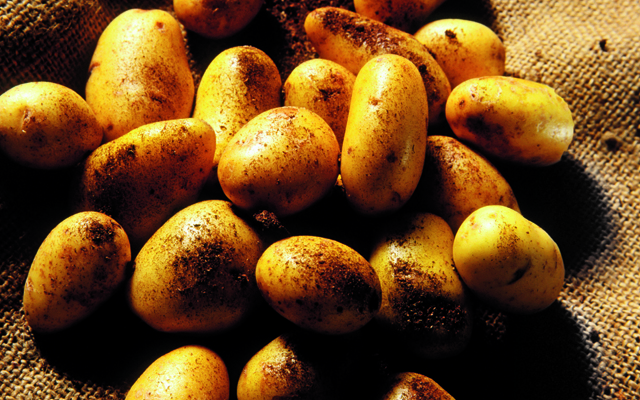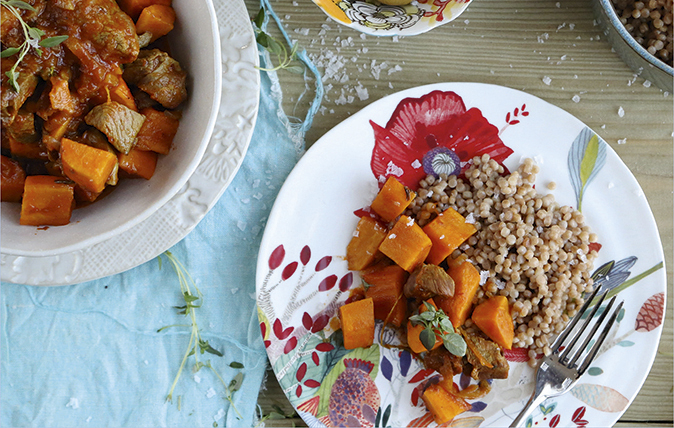New varieties of potatoes to try
Angela Clutton unearths the tastiest and most distinctive regional varieties of new potatoes.


The new season is starting to beckon in an enticing way for gardeners and cooks. Those indulging in thoughts of the flavours and colours to come can make them more tangible by using this first part of the spring to plant a crop of early potatoes. These ‘new’ potatoes receive justified fanfare when they arrive in shops and markets in early summer, and it’s even more exciting when the homegrown first earlies and second earlies, which are ready not long after produce potato flowers that flag up the promise of delicious potatoes below.
There are marked differences between the size, flavour, texture and colour of earlies depending on the variety. Where and how they are grown is key, as demonstrated by a taste test of three different varieties all grown within Northern Ireland’s Protected Geographical Indication (PGI) status region of Comber.
The producers farming Comber earlies in this small area share the same relatively dry and warm soil and mild climate. Their earlies have an earthy, sweet, nutty flavour and soft skin, yet even within that small area, different varieties all possess discernible idiosyncrasies of flavour and colour.
Home Guard, one of the prime Comber early crops, gained its sobriquet thanks to the volunteers who promoted its use when it was introduced during the Second World War. Its consistently high and early yield made it a useful crop and it’s still a good choice now. With pure-white flowers, skin and flesh, it’s a beauty of a potato that’s perfect for those who are keen to get their earlies as early as possible. Once harvested, Home Guard is best enjoyed simply steamed and served with butter so its flavour can ring out.
Another heritage variety worth looking out for is British Queen. It also has wartime roots, having been part of the staple diet through both World Wars. This one is a second early with a slightly floury texture, which makes it more suited to a variety of cooking methods than some others and its RHS Award of Garden Merit is testament to the breeding skill of Archibald Findlay in Fife in the late 1800s.
On the opposite coast of Scotland, Epicures that are adept at withstanding frost are particularly popular, many of which arrive before the Ayrshire earlies. Chilly mornings aside, there is much to commend the climate for growing earlies. The sandy soil and salty air, plus the warm Gulf Stream waters, play their part in creating potatoes of excellent texture and taste.
As Dorothy Hartley wrote in her 1950s book Food In England, new potatoes ‘grow well in the sandy soil of seaside bungalows’. The balmy influence of the Gulf Stream is the potato-grower’s friend and a significant factor in why Pembrokeshire’s earlies are so reknowned that they also enjoy PGI status. Here, Maris Peer earlies are a popular variety; they have a creamy yellow flesh that withstands cooking without disintegrating or losing flavour and their scented purple flowers make them a joy to grow.
Exquisite houses, the beauty of Nature, and how to get the most from your life, straight to your inbox.
Bringing similar brightness to the potato patch are Red Duke of Yorks, another RHS Award of Garden Merit plant. These first earlies generously extend their brilliance to the kitchen and the plate, too, as they are one of the few to flourish with a ruby skin that contrasts with the potato’s yellow flesh.
However, for many of us, the good old Jersey Royal is still the classic summer new potato of choice. We should really call them International Kidneys, but over the years, they’ve become known as Jersey Royals and must be grown on the island to be allowed the name. It would, however, be interesting to grow them elsewhere to see how much of their distinctive flavour comes from the variety itself. Whatever variety you choose, digging up those first new potatoes is truly one of the best times of the year in the garden.
Seven of the best new varieties:
- Epicure Known for its deep eyes, it’s a good choice for colder parts of the UK
- Sharpe’s Express These pear-shaped heritage potatoes have been grown since about 1900
- Maris Peer Small salad potatoes with a light, fresh flavour
- Red Duke of York It was first found within a Dutch crop of Duke of York potatoes
- British Queen Distinguished by white skin, white flesh and many eyes, this spud has an old-fashioned look about it
- Home Guard It has beautiful white flowers and is best eaten early
- International Kidney A Jersey Royal variety that’s excellent for salads
Know your spuds:
- In Cheshire, yellow wagtails are known as ‘potato droppers’ by growers, who believe early potatoes shouldn’t be planted until the birds have returned
- Some growers of earlies gauge their planting by the first shout of the cuckoo
- Sharpe’s Express was TV gardener Percy Thrower’s favourite first early
Where to buy seed potatoes: Thompson & Morgan (0844 573 1818; www.thompson-morgan.com) JBA Seed Potatoes (01461 202567; www.jbaseedpotatoes.co.uk) Suttons Seeds (0333 400 2899; www.suttons.co.uk) Carroll’s Heritage Potatoes (01890 883060; www.heritage-potatoes.co.uk)
Local potato seed fairs are also a good place to find interesting varieties

Different ways with potatoes
Roasted with rosemary and sea salt, or baked into a galette and served with smoked salmon: just two of our

Sweet potato and lamb tagine
Chopped into wedges and served with pheasant goujons, or stewed in a lamb tagine: just two of our favourite sweet
Country Life is unlike any other magazine: the only glossy weekly on the newsstand and the only magazine that has been guest-edited by His Majesty The King not once, but twice. It is a celebration of modern rural life and all its diverse joys and pleasures — that was first published in Queen Victoria's Diamond Jubilee year. Our eclectic mixture of witty and informative content — from the most up-to-date property news and commentary and a coveted glimpse inside some of the UK's best houses and gardens, to gardening, the arts and interior design, written by experts in their field — still cannot be found in print or online, anywhere else.
